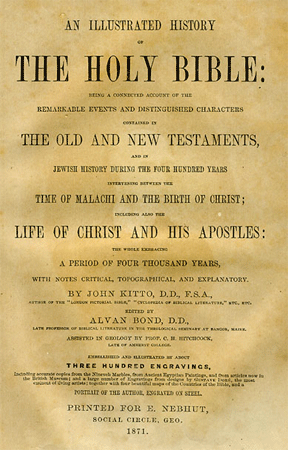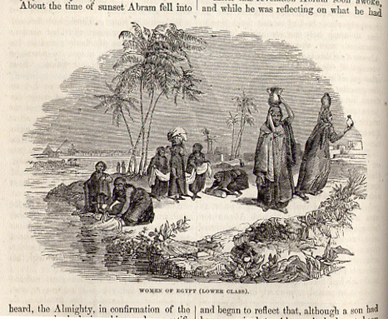
As a child I spent many inquisitive hours leafing through the books in my grandmother’s parlor bookcase. One that especially attracted my attention was John Kitto’s An Illustrated History of the Holy Bible (Social Circle, Georgia: E. Nebhut, 1871). Rev. John Kitto, recognized on the title page as author of the London Pictorial Bible, the Cyclopedia of Biblical Literature, ETC, ETC, retells the entire history of the Old and New Testament, from creation to the destruction of Jerusalem. Kitto was born into poverty in 1804 in Plymouth, England and due to an unfortunate accident ate age thirteen became entirely deaf and was forced into the poor house at the age of fifteen. This is quite an inauspicious beginning for a waif who went on to be a respected theological scholar. Through the local humanitarian efforts of several men in Plymouth, Kitto became a lay missionary to Malta and then for three and a half years in Baghdad. “While residing in that city,†writes Alvan Bond in the preface to Kitto’s book, Cairo “was visited by the plague, the terrific ravages of which swept off more than one-half the inhabitants in two months. Amidst this fearful desolation he remained calm and active at his post.†Once back in England he married and produced a travel account and several pictorial histories of the Holy Land. In 1844 the University of Giessen conferred upon him the degree of D.D. His ill health forced him to seek help in the spas of Germany, where he died after a mere half century in 1854.
Spread throughout this text are inserts with wrappers of the biblical art of Gustave Doré. The woodcuts of Gustave Doré (1832-1883) were widely distributed in Bibles and books about the Bible in the late 19th century. In his text, Kitto rarely refers to contemporary Arabs or customs in Bible lands, yet many of the embedded illustrations show contemporary scenes rather than artistic reconstructions of the biblical stories. I suspect that these were added by the editors rather than chosen by the author. In the discussion of Abram’s (i.e. Abraham) visit to Egypt, there is a scene of contemporary “Women of Egyptâ€, although there is only indirect discussion about contemporary Egyptians in the text.

Here is the description provided by Kitto (pp. 98-99):
Sarai, the wife of Abram, desired a son no less fervently than her husband. But she had been considered barren before she left Mesopotamia; she was now seventy-five years of age; and she had waited ten years since their hearts were first gladdened by the promise of an heir. She therefore thought the case was hopeless as regarded herself;and began to reflect that, although a son had been promised to Abram, it had not been said, and did not necessarily follow, that this son should be the fruit of her own womb. Explaining these views to the patriarch, she prevailed upon him to resort to a custom of the time, of which there are still some traces in the East, under which the man takes a secondary wife, whose children become his undoubted heirs, equally with any other children he may have; and if the woman is the slave or attendant of the chief wife, the children are, in a legal point of view, considered hers; and, in the same point of view, the condition of the actual mother remains unchanged, though in practice it necessarily sustains some modification from the operation of the feelings arising from the connections which are formed, especially when her children are grown up.
One wonders if father Abraham needed all that much convincing to take Hagar as the father of his child. But Kitto shows his prejudicial view of “Eastern” women with the following parenthetical comment on Hagar’s apparent treatment of Sarai with disrespect: “(which those who know any thing of Oriental women of her class, will believe to have been very coarsely and offensively manifested).” Physical deafness was not the only malady affecting the biblical scholar, who was very much a product of his age.
Daniel Martin Varisco